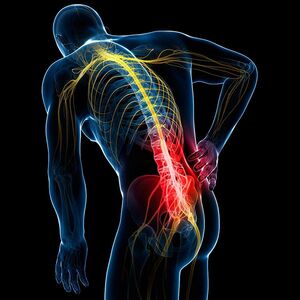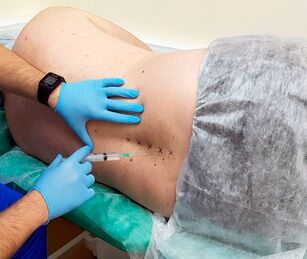According to medical statistics, acute back pain is the second most common cause of disability. At least 80% of people suffer from them at least once. They may occur sporadically or may be noticed during exacerbation of spinal disease. But in any case, acute and chronic back pain require competent treatment and targeted action on the causes of their occurrence.
Acute back pain: causes

Acute pain is one that lasts less than 6 weeks. For most, it disappears within 2 weeks. Although at first it is impossible to predict how long it will take. However, in almost half of the cases, similar or more severe attacks recur later and become chronic pain.
Acute pain can be of varying intensity, dull, burning, etc. Sometimes it radiates to the arms, legs, buttocks. The so-called back pain often occurs after hypothermia, excessive physical effort and as a result of sprains. A few days may pass between the influence of the traumatic factor and the direct manifestation of the pain syndrome, and it will manifest itself under the influence of a slight physical effort, for example, bending.
They can also be the result of a back injury or the first manifestation of a spinal disease, including:
- osteochondrosis;
- intervertebral hernia; spondyloarthritis;
- spinal stenosis, etc.
Increase the likelihood of back problems:
- frequent stress;
- regular increased physical activity;
- overweight;
- frequent and prolonged standing.
With severe back discomfort, headaches, tingling in the legs, and dizziness may be present. All of these symptoms must be reported to a doctor at an appointment.
No matter which anatomical structure is damaged first, it pulls a whole chain of successive changes that increase discomfort. Initially, inflammatory factors are formed in the lesion, which cause swelling and irritate the nerve fibers. In response, muscle spasm often occurs, which further worsens the situation and causes circulatory disorders in the affected area. This leads to a reduction in the amount of nutrients and oxygen that enter the focus of the lesion, as well as the retention of metabolic products in it.
Treatment of acute back pain
To relieve pain, lie on your back on a hard surface. This will allow the back muscles to relax and relieve stress on the spine. To enhance the effect, orthopedic pillows can be placed under the knees and under the head, but it is important to avoid relaxation in the lower back. In addition to severe pain, short-term intake of NSAIDs is allowed. In the future, you must definitely contact a neurologist or spinal surgeon to determine the cause of the pain syndrome.
You should see a doctor as soon as possible if there is no improvement, recurrence of the attack or radiation pain in the feet or knees, violation of urination and defecation within a week. To diagnose existing disorders, patients are shown:
- MRI;
- CT;
- X-ray;
- biochemical blood test;
- UAC.
Based on the results of the research and the characteristics of the symptoms, the doctor makes a diagnosis and develops treatment tactics. In the case of acute pain that deprives a person of their ability to work, they may be offered a spinal block that relieves the pain in a matter of minutes.
Once the discomfort subsides, it is important not to stay in bed. Moderate physical activity, supplemented by special exercises in medical gymnastics, is the best prevention of recurrence of such attacks in the future.
When you go to the hospital, you will surely get a high quality treatment for the pain syndrome and its causes. Experts will be able to develop the most effective treatment tactics and quickly relieve pain with the help of a well-made, accessible blockade.
Chronic back pain: causes
People equally often suffer from chronic back pain. They can get worse and turn into an attack of acute pain, which completely rejects the person from the usual rhythm. The most common results are:
- Sedentary lifestyle, which leads to weakening of the muscular corset. This provokes an increase in the load on the spine and compression of the vertebrae. The result is osteochondrosis, protrusion of intervertebral discs and herniation of intervertebral discs, spondyloarthritis.
- Posture disorders. Prolonged preservation of any position of the body, in which the natural curves of the spine are disturbed, causes its curvature and the development of scoliosis or kyphosis. This involves degenerative changes in the intervertebral discs, redistribution of the load on the muscles, and contraction of the nerve roots.
- Weakening of the abdominal muscles. Because they act as a support to the internal organs and partially relieve the spine, when they are weak, the load on the lower back increases, which increases lordosis and causes chronic pain. In addition to a sedentary lifestyle, weakening of the abdominal muscles can be the result of pregnancy or obesity.
- Age changes. Over the years, the intervertebral discs gradually dehydrate, causing a decrease in their elasticity, strength, and size. The annular fibrosus surrounding the nucleus pulposus dries out and becomes more brittle. Loads cause cracks to form in it, leading to bulges and hernias. The resulting bulge can constrict nearby blood vessels, nerve roots, spinal cord, which provokes the appearance of pain syndrome.
Chronic back pain diseases include:
- osteochondrosis; spondyloarthritis; osteoporosis;
- intervertebral hernia; facet syndrome;
- ankylosing spondylitis; spondylolisthesis; rheumatoid arthritis;
- intercostal neuralgia;
- oncological diseases and others.
A common cause of chronic pain is worsening of facet joints. The cartilage found in them is also prone to thinning with excessive stress on the spine. As a result, when they move, they stop performing the function of absorbing shocks, which causes friction of bone fragments and the development of inflammation.
Treatment of back pain
Treatment tactics are developed based on which disorders are found during diagnostic studies. When spinal diseases are detected, conservative therapy is initially prescribed, including:
- drug therapy;
- physiotherapy;
- massage;
- Exercise therapy.
Conservative therapy
A holistic, individualized approach is important in the treatment of back pain. Depending on the cause, patients are prescribed a number of medications, especially:
- NSAIDs - drugs from this group have anti-inflammatory and analgesic effects, but with prolonged use negatively affect the condition of the digestive tract;
- corticosteroids - drugs with pronounced anti-inflammatory properties, prescribed in moderate to severe cases;
- muscle relaxants - help eliminate increased muscle tone and cramps;
- antidepressants - help eliminate psychological discomfort, which often reduces the effectiveness of conservative therapy;
- topical agents - ointments or gels that contain anti-inflammatory, heating or cooling components can help reduce the severity of pain and cause virtually no side effects;
- chondroprotectors - preparations containing glucosamine and chondroitin have a beneficial effect on the condition of cartilage tissue, increase its elasticity and help restore normal thickness.

In mild cases, oral medications are sufficient. But in more complex situations, patients may be prescribed intra-articular injections. In case of severe pain, blockade once or as a complete course is recommended, which can contain up to 10 procedures.
In order to increase the effectiveness of drug therapy, patients are prescribed massages and physiotherapy. The correct effect on the back muscles helps to activate the blood and lymph, improves metabolic processes and eliminates muscle cramps. Manual therapy is very effective in spinal deformities, especially scoliosis of 1-2 degrees. Regular sessions help to restore the normal position of the spine and relieve the pressure on the internal organs.
As part of physiotherapy, patients are assigned sessions:
- UHF;
- magnetic therapy;
- Bernard currents;
- laser therapy;
- electrophoresis;
- UFO;
- balneological treatment.
If it is not possible to improve the condition within six months or there is a risk of complications, patients may be offered surgical treatment of existing diseases.
Surgical treatment
Modern methods of surgical intervention are characterized by a high degree of efficiency and safety. They allow you to quickly remove the pathological cause of the development of pain syndrome and often do not require a hospital stay. But most minimally invasive and microsurgical methods can be applied only when patients are referred to spinal surgeons in the early stages of the disease.
Indications for surgical treatment are:
- progressive herniation of intervertebral discs;
- spinal stenosis;
- sequestered hernia;
- spinal fractures;
- scoliosis 3-4 degrees;
- severe forms of spondyloarthritis;
- compression of the spinal cord or its nerve roots;
- hemangiomas of the vertebral body;
- instability of certain segments of the spine;
- cauda equina syndrome.
The surgeon determines the type of surgery based on the severity of the patient's condition. With the same diagnosis, surgical treatment can be performed in different ways, varying in degree of invasiveness, efficacy, duration of rehabilitation, and cost.
Minimally invasive methods of surgical treatment have become very popular recently. With their help, treatment of intervertebral protrusions, hernias of intervertebral discs, hemangiomas and a number of other diseases is carried out. Minimally invasive surgery lasts no more than an hour, and after its completion, the patient can walk almost immediately and leave the clinic the same or the next day.

The great advantages of the method are a good cosmetic effect (in most cases, all injected surgical instruments are inserted through perforations of soft tissues), ease of rehabilitation and affordable price. In the case of intervertebral hernias, only cold nucleoplasty or plasma hydroplasty (hydrodiscectomy) can be considered a promising method.
In situations where microsurgical techniques cannot be applied, surgeons perform open surgeries. During them, it is possible to completely remove pathologically altered formations, smooth out serious deformities of the spine, replace irreplaceable structures with implants and achieve normal functioning of the spine by placing metal titanium constructions.
Modern spine surgery is able to solve almost any back problem. All the latest methods of surgical treatment of spinal diseases are available in many institutions. A team of doctors of different profiles will help to get rid of acute or excruciating chronic back pain as soon as possible.
Prevention of back pain
Once the attack is over and the pain subsides, it is recommended to avoid the second episode:
- do not lift too heavy objects;
- do not bend;
- walk more;
- give up hard physical work;
- When you sit down, take regular breaks to warm up.



































